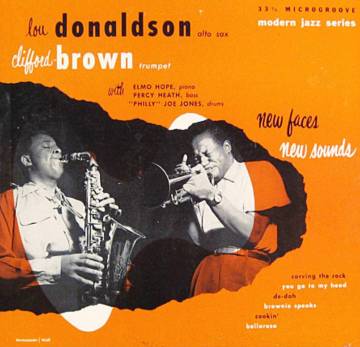One of the must-haves. Clifford Brown & Max Roach is a brilliant, textbook example of balanced storytelling, responsive interplay and vital, fluent swing.
Personnel
Clifford Brown (trumpet), Harold Land (tenor saxophone), Richard Powell (piano), George Morrow (bass), Max Roach (drums)
Recorded
on August 2, 3 & 6, 1954 at Capitol Studios, Los Angeles
Released
as MC 26043 in 1954
Track listing
Side A:
Delilah
Parisian Thoroughfare
Side B:
Daahoud
Joy Spring
Jordu
Straight from the short-lived 10-inch era of the early/mid-fifties, Clifford Brown & Max Roach. Five tunes, two instant classics and standards, 30 minutes of sizzling, masterful modern jazz. What more could one ask for? If you can’t say it in a mere half hour, you better cut it out… To be sure, when EmArcy switched to the 12-inch format in the slipstream of bigger labels like Columbia, three tunes of the August 1954 session were added. Max Roach and rising trumpet star Clifford Brown initially formed a quintet with, respectively, Sonny Stitt and Teddy Edwards.
The quintet finally gelled into a subtle, driving cooperative unit with Harold Land, who was relatively unknown at that time but immediately made his name through his excellent work with Brown/Roach. Finally, Land was followed up by Sonny Rollins, who completed a notorious outfit that came to its abrupt end in 1956 when Clifford Brown and pianist Richard Powell were tragically killed in a car crash.
The stays of some jazz legends on planet Earth were cut short much too soon. Charlie Christian, Scott LaFaro and… Clifford Brown. But the impact of these searchers for new vistas has been penetrating and everlasting. Clifford Brown displayed a balanced vitality that is rarely if ever matched. He transformed tragedy into a smile. His music comes out cleanly and gaily through his horn. Bit of a heir to Louis Armstrong, if you ask me… A bittersweetly happy, completely authoritative virtuoso. The Crown Prince, if you will.
Max Roach was thirty years old at the time of recording Clifford Brown & Max Roach, veteran of bop that took the revolutionary rudiments of Kenny Clarke and fulfilled the quintet format with Charlie Parker, a blaze of new accents, motives, melodicism. He’s the glue of the quintet, which delivers an unusual brew of virility, balance and fluent swing. Once Delilah is underway for barely one minute, you know you’re in for a treat. As in a bee colony, proceedings go as planned, there’s a definite sense of order while all members dart this and that way frivolously and seemingly at random. Roach succinctly supports the movement of the changes, Morrow and Powell provide the solid framework for the soloists, a simultaneously smooth and driving flow and a paradise for Harold Land, who takes a wonderful first shot, simultaneously at ease and insistent.
Clifford Brown is the queen bee. Daahoud is his habitat. Daahoud was an instant classic. Uptempo bouncing ball… A wave of fresh air, springtime breeze accompanying the swarm of bees at the country farm… Clifford Brown is the frivolous bee, giving birth to lean flights in the upper register that serve as the apex of a brilliant package of honey notes, deceptively simple, fluent phrasing, relentless swing that makes us very… happy. His attack is ferocious yet smooth. The ideas keep coming. Brown plays a Socrates-que discours of question and answer with himself and talks shop with his partners, intuitively, a game of hi-level split seconds. Max Roach hits the pocket almost Blakey-style, a kick start to the soloist’s story on the one hand, a crash cymbal bash to signal the next in line on the other hand.
Talkin’ about Spring. Joy Spring cannot be left unmentioned. The other instant classic, the lovely melody that Clifford Brown wrote for his wife, nicknamed “Joy Spring”. Don’t you want to be called Joy Spring? Joy Spring, you’re the sweetest… Joy Spring, dinner is ready!… Joy Spring, I warmed your spot, please come on up… None of that seven-year itch with husband and Joy Spring! The mid-tempo, relaxed bounce underlines Brown’s affectionate, sweet but tart words of love.
Bud Powell’s Parisian Thoroughfare offers more vital features by Brown and Roach, whose effective simplicity as a soloist is admirable. Roach plays like a horn player. Richard Powell, brother of Bud, hooks up with the strikingly boogie-woogie-ish drive of the bop anthem. The quintet rounds off the 10inch platter with Duke Jordan’s contagious blues-based Jordu, a version as lovely and enticing as a Lotus flower. It is as if these men contaminated each other with the fever of nuanced storytelling, virile swing, fluidity, ideas… Clifford Brown And Max Roach is a very “ill” album indeed! Not to mention “dope” or “master” or whatever youngsters call spectacular these days. Something I’m not aware of I’m sure. I’m old-fashioned and I don’t mind it…



